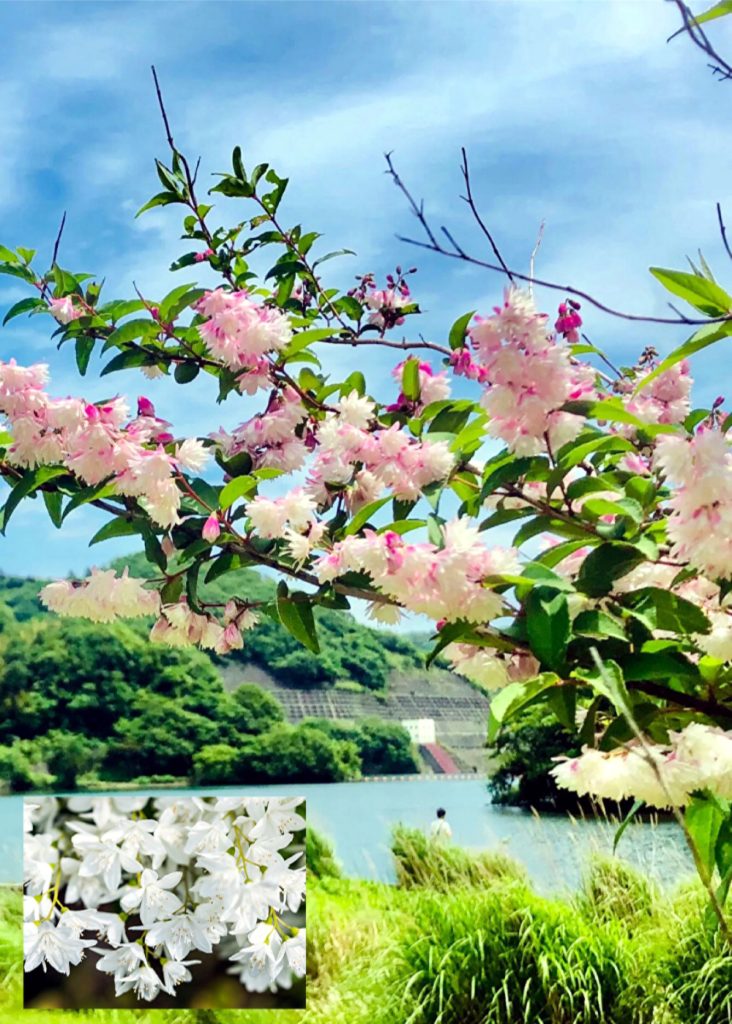
《In the Fragrant Hedge of Unohana Flowers, the Little Cuckoo Also Sings Early》
The season when the uno-hana (deutzia flower) bloom has arrived. It is called “uno-hana” because it blooms in the fourth month of the old lunar calendar, or it might be that the month is called “uzuki” because uno-hana bloom during this month. Either way, the uno-hana has been familiar to Japanese people since ancient times. Indeed, the Manyoshu (a collection of ancient Japanese poems) contains 24 poems that mention uno-hana. Moreover, 18 of those poems are composed together with mentions of the hototogisu (little cuckoo). Since ancient times, both have been symbols of early summer. In The Pillow Book, there is a section called “Uno-hana-guruma” (Uno-hana Cart) that describes ladies decorating ox-drawn carriages with deutzia flowers, and here too the hototogisu makes an appearance.
The lyricist of “Natsu wa Kinu” (Summer Has Come) is Sasaki Nobutsuna, and as a scholar of Japanese literature, he was well aware of these circumstances and incorporated them into his poem. The plant name for uno-hana is “utsugi,” and its name comes from the fact that its stem is hollow, hence “utsugi” (empty tree). While uno-hana is an abbreviation of , there is also the theory that it blooms in the fourth lunar month. Dr. Tomitaro Makino stated this, and he also mentioned that uno-hana is an abbreviation of utsugi flowers.
Setting aside the complicated details, let’s listen to “Natsu wa Kinu (Summer Has Come).”
《卯の花の匂う垣根に ホトトギス早も来鳴きて》
卯の花が咲く季節になりました。卯月(旧暦4月)に咲くからウノハナ(卯月の花)と呼ばれるようになったのか、卯の花が咲く月だから卯月になったのかよくわかりませんが、ウノハナは万葉の昔から日本人に慣れ親しんできた花に違いありません。確かに万葉集にはウノハナを詠んだ歌が24首収められています。しかも、そのうち18首がホトトギスと共に詠まれています。古い時代から、両者ともに初夏の風物詩だったのでしょう。枕草子にも「卯の花車」と言う段があって、女房たちが牛車に卯の花を飾り立てている様子が書かれていて、ここにもホトトギスが登場します。
『夏は来ぬ』の作詞者は佐々木信綱ですが、彼は国文学者なので、こういう事情はよく知っていて上の詩に結び付いたのでしょう。ウノハナの植物名は「ウツギ」ですが、ウツギという名の由来は、「空木と言う意味で、幹の中が中空であるところからきたもの。ウノハナはウツギの花の略とされたものであるが、卯月に咲くという説もある。」と牧野富太郎博士は述べています。牧野先生は「ウノハナはウツギ花の略とされたもの」とも言っているのです。
ややこしいことはさておいて、『夏は来ぬ』を聞いてみることにしましょう。
